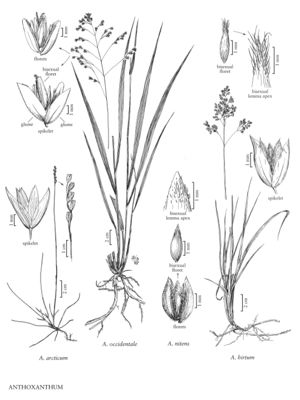Difference between revisions of "Anthoxanthum hirtum"
FNA>Volume Importer |
FNA>Volume Importer |
||
| Line 28: | Line 28: | ||
-->{{Treatment/Body | -->{{Treatment/Body | ||
|discussion=<p><i>Anthoxanthum hirtum</i> is the most widely distributed species of <i>Anthoxanthum</i> in the Flora region, extending from Alaska to northeastern Quebec and south to Washington and Colorado, South Dakota, Illinois, Ohio, and New York. It is not known from Newfoundland or Greenland. Outside the Flora region, it extends from Scandinavia south to Germany and east to Asiatic Russia. It grows in wet meadows and marshes with good water, not in salt- or brackish water. Because much of its native habitat has been drained, it is becoming less common. Its short flag leaf blades and more circular spikelets distinguish it from <i>A. occidentale</i>, and the relative abundance and even distribution of hairs longer than 0.5 mm distinguish it from <i>A. nitens</i>.</p><!-- | |discussion=<p><i>Anthoxanthum hirtum</i> is the most widely distributed species of <i>Anthoxanthum</i> in the Flora region, extending from Alaska to northeastern Quebec and south to Washington and Colorado, South Dakota, Illinois, Ohio, and New York. It is not known from Newfoundland or Greenland. Outside the Flora region, it extends from Scandinavia south to Germany and east to Asiatic Russia. It grows in wet meadows and marshes with good water, not in salt- or brackish water. Because much of its native habitat has been drained, it is becoming less common. Its short flag leaf blades and more circular spikelets distinguish it from <i>A. occidentale</i>, and the relative abundance and even distribution of hairs longer than 0.5 mm distinguish it from <i>A. nitens</i>.</p><!-- | ||
| − | --><p>Weimark (1971,1987) recognized three subspecies in <i>A. hirtum</i> (which he treated as Hierochloe hirta): subsp. hirta, <i></i>subsp.<i> arctica</i> G. Weim., and subsp. praetermissa G. Weim. He stated that only <i>H. hirta</i> <i></i>subsp.<i> arctica</i> grows in North America, but several North American specimens seem to fit within his circumscription of <i>H. hirta</i> subsp. hirta. Because the variation between the two appears continuous, no subspecies of <i>A. hirtum</i> are recognized here.</p> | + | --><p>Weimark (1971,1987) recognized three subspecies in <i>A. hirtum</i> (which he treated as Hierochloe hirta): subsp. hirta, <i></i></i>subsp.<i><i> arctica</i> G. Weim., and subsp. praetermissa G. Weim. He stated that only <i>H. hirta</i> <i></i></i>subsp.<i><i> arctica</i> grows in North America, but several North American specimens seem to fit within his circumscription of <i>H. hirta</i> subsp. hirta. Because the variation between the two appears continuous, no subspecies of <i>A. hirtum</i> are recognized here.</p> |
|tables= | |tables= | ||
|references= | |references= | ||
| Line 48: | Line 48: | ||
|publication year= | |publication year= | ||
|special status= | |special status= | ||
| − | |source xml=https://jpend@bitbucket.org/aafc-mbb/fna-data-curation.git/src/ | + | |source xml=https://jpend@bitbucket.org/aafc-mbb/fna-data-curation.git/src/f6b125a955440c0872999024f038d74684f65921/coarse_grained_fna_xml/V24/V24_1083.xml |
|subfamily=Poaceae subfam. Pooideae | |subfamily=Poaceae subfam. Pooideae | ||
|tribe=Poaceae tribe Poeae | |tribe=Poaceae tribe Poeae | ||
Revision as of 19:13, 24 September 2019
Plants perennial; loosely cespitose or the culms solitary, rhizomes elongate, 0.7-2 mm thick. Culms 40-85(110) cm. Sheaths brownish or reddish; ligules 2.5-5.5 mm; blades 2.5-5.5 mm wide; abaxial surfaces glabrous, shiny, adaxial surfaces pilose; flag leaf blades 1-4.5(6) cm long, 3-4.5 mm wide. Panicles (5)7.5-15 cm long, 2-10 cm wide, open, pyramidal, with 20-100+ spikelets; branches with 3+ spikelets. Spikelets 4-6.3 mm, tawny at maturity; rachilla internodes 0.1-0.3 mm. Glumes subequal, exceeding the florets, glabrous, often somewhat purplish; lowest 2 florets staminate; lemmas 3-5 mm, with hairs to 0.5 mm towards the apices, margins with 16-30 hairs per mm, hairs 0.5-1 mm, apices acute, emarginate, or bifid; first lemma 3-5 mm long, 1.1-1.5 mm wide, length usually less than 4 times width, elliptic, awned, awns 0.1-1 mm; bisexual lemmas 2.9-3.5 mm, hairy distally, hairs 0.5-1 mm, evenly distributed around the apices, bases strongly divergent from the lemma surface; anthers of staminate florets 1.6-2.1 mm, those of bisexual florets 1.2-1.3 mm. 2n = 56.
Discussion
Anthoxanthum hirtum is the most widely distributed species of Anthoxanthum in the Flora region, extending from Alaska to northeastern Quebec and south to Washington and Colorado, South Dakota, Illinois, Ohio, and New York. It is not known from Newfoundland or Greenland. Outside the Flora region, it extends from Scandinavia south to Germany and east to Asiatic Russia. It grows in wet meadows and marshes with good water, not in salt- or brackish water. Because much of its native habitat has been drained, it is becoming less common. Its short flag leaf blades and more circular spikelets distinguish it from A. occidentale, and the relative abundance and even distribution of hairs longer than 0.5 mm distinguish it from A. nitens.
Weimark (1971,1987) recognized three subspecies in A. hirtum (which he treated as Hierochloe hirta): subsp. hirta, subsp. arctica G. Weim., and subsp. praetermissa G. Weim. He stated that only H. hirta subsp. arctica grows in North America, but several North American specimens seem to fit within his circumscription of H. hirta subsp. hirta. Because the variation between the two appears continuous, no subspecies of A. hirtum are recognized here.
Selected References
None.
